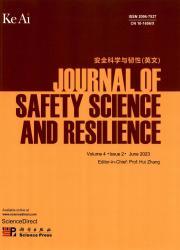实现可持续发展目标不足的风险预测:一个腐败的视角
IF 3.4
Q1 PUBLIC, ENVIRONMENTAL & OCCUPATIONAL HEALTH
引用次数: 0
摘要
了解腐败与可持续发展目标(SDGs)之间的关系对于全面应对可持续发展挑战至关重要。腐败对治理、机构和公众信任具有破坏性影响,是实现可持续发展目标的巨大障碍。本研究探讨了国家层面的腐败风险与实现可持续发展目标相关风险之间的相互联系。利用与国家层面的可持续性和腐败表现相关的两个数据集开发了贝叶斯信念网络模型。该模型在预测两种极端腐败风险水平的结果时,准确率高达 86.3%。研究结果表明,"高风险 "腐败状态会严重阻碍 "良好的健康和福祉"、"零饥饿 "以及 "和平、公正和强有力的机构 "可持续发展目标的实现。反之,"低风险 "的腐败状态则能显著提高 "可持续城市和社区"、"零饥饿 "和 "无贫困 "可持续发展目标的绩效。本研究探讨了腐败与可持续发展目标风险之间的相互关系,为决策者提供了宝贵的见解。它的贡献在于从风险科学的角度研究了腐败与可持续性之间的依存关系,捕捉到了所有 17 项可持续发展目标之间的相互作用。本文章由计算机程序翻译,如有差异,请以英文原文为准。
Risk forecasting for shortfalls in achieving sustainable development goals: A corruption perspective
Understanding the relationship between corruption and Sustainable Development Goals (SDGs) is essential for comprehensively addressing sustainable development challenges. Corruption, with its damaging impact on governance, institutions, and public trust, poses a substantial barrier to achieving the SDGs. This study investigates the interconnections between corruption risk at the country level and the risks associated with achieving the SDGs. A Bayesian belief network model is developed using two datasets related to country-level sustainability and corruption performance. The model yields an 86.3 % accuracy in predicting outcomes for the two extreme levels of corruption risk. The findings indicate that the “high risk” state of corruption can significantly hinder progress on the “good health and well-being,” “zero hunger”, and “peace, justice and strong institutions” SDGs. Conversely, the “low risk” state of corruption can significantly enhance performance on the “sustainable cities and communities”, “zero hunger”, and “no poverty” SDGs. This study's exploration of the interconnected relationship between corruption and SDG risks offers valuable insights for policymakers. Its contribution lies in examining the dependencies between corruption and sustainability from a risk science perspective, capturing interactions across all 17 SDGs.
求助全文
通过发布文献求助,成功后即可免费获取论文全文。
去求助
来源期刊

安全科学与韧性(英文)
Management Science and Operations Research, Safety, Risk, Reliability and Quality, Safety Research
CiteScore
8.70
自引率
0.00%
发文量
0
审稿时长
72 days
 求助内容:
求助内容: 应助结果提醒方式:
应助结果提醒方式:


